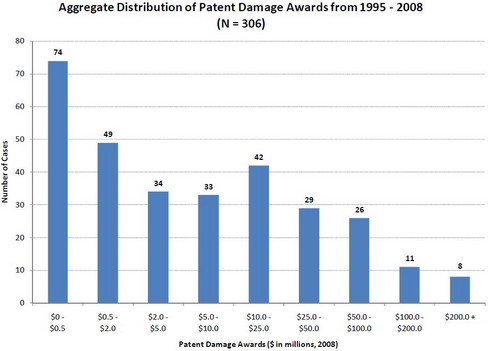This is a guest Post by Michael J. Mazzeo, Jonathan Hillel and Samantha Zyontz[1]
Our analysis of a new dataset challenges the assumptions on which the Patent Reform Act is based and questions the need for damages law reform. Damages provisions of the Patent Reform Act, the latest version of which was recently introduced for vote in the Senate, are premised on concerns that awards are “too often excessive”[2] and those large verdicts featured in media headlines “represent the tip of the iceberg” of excessive awards.[3] Last week at the inaugural Samsung-Stanford Patent Remedies Conference, we presented a very different picture of patent infringement damages.
In our prize-winning study, “Are Patent Infringement Awards Excessive?: The Data Behind The Patent Reform Debate”, we compile a dataset comprising infringement awards from over 300 cases decided in US federal courts between 1995 and 2008. We build on a proprietary dataset from PricewaterhouseCoopers, supplementing it with information about the litigants, lawsuits and economic value of the patents-at-issue. Using standard statistical techniques and regression analysis, we search for evidence of “excessive” awards. Certain of our key findings are summarized below:
1. The eight largest awards represent nearly half of the total amount of damages in our dataset. As shown below, the distribution of damages is highly skewed, and awards in the largest eight cases represent over 47% of cumulative damages.
2. Patent infringement damages are highly predictable. We perform an 80-variable log-linear regression analysis that explains nearly 75% of the variation in the observed awards. As shown below, the first-order results of our regression indicate that juries and large defendants are correlated with higher awards.
To continue reading, become a Patently-O member. Already a member? Simply log in to access the full post.
